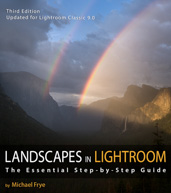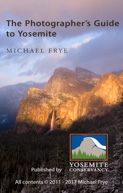In the Moment:
Michael Frye's Landscape Photography Blog
by Michael Frye | Jul 13, 2010 | Announcements, Workshops
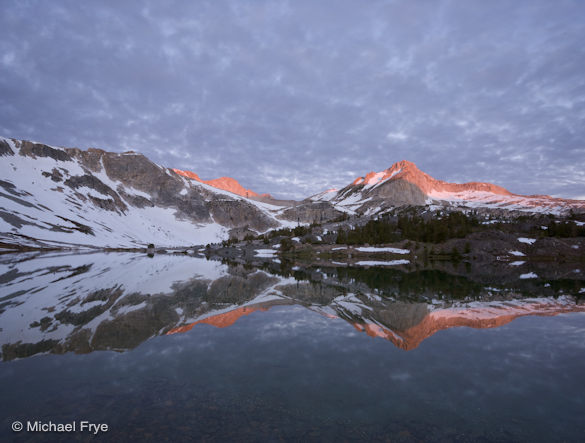
North Peak and Greenstone Lake, sunrise
I just finished teaching the Hidden Yosemite workshop for The Ansel Adams Gallery. Every year this is a really fun class, and this time was no exception. There’s something about being away from the roads that adds an extra dimension to the workshop. We had a great group, and the weather was excellent. Saturday morning at Greenstone Lake was probably the photographic highlight, with glassy water and a great mix of sun and clouds—the first time I’ve seen clouds at sunrise from this spot. The photograph above shows the first blush of light on North Peak; later, in the image below, I used a four-stop neutral-density filter, plus a polarizer, to slow the shutter speed and blur the fast-moving clouds.
We had a slide show on the last day of the workshop, and everyone in the class showed great images from Saturday morning—how could you miss with light like that? But we also saw many interesting, imaginative photographs from all the other locations we visited. It was great to see everyone’s growth over the five days of the workshop. I’ll post a link to some of the student’s photos at some point.
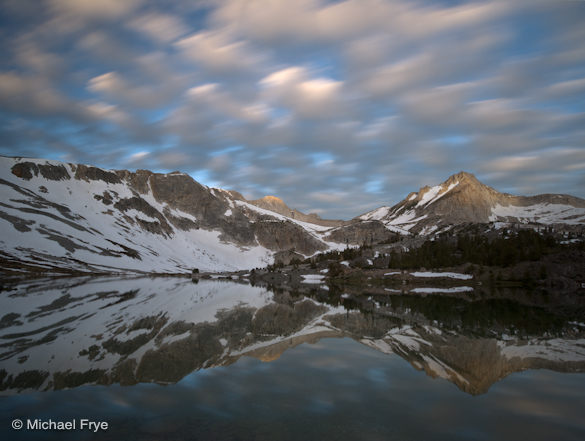
Fast-moving clouds above Greenstone Lake
by Michael Frye | Jul 5, 2010 | Yosemite Photo Conditions
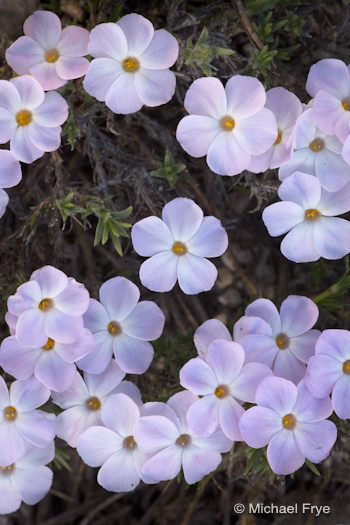 Claudia and I spent Fourth of July weekend in the Yosemite High Country, scouting for my upcomingHidden Yosemite workshop. There’s still plenty of water flowing in the creeks and rivers, and some big reflecting ponds remain in the west end of the main Tuolumne Meadow. Some flowers have appeared, like the spreading phlox shown here, penstemon along the side of the Tioga Pass Road between Yosemite Creek and Olmsted Point, and a few patches of shooting stars in damp meadows. I’m sure more flowers will be blooming soon. It promises to be a good wildflower year in the high country, but the peak probably won’t arrive until at least early August.
Claudia and I spent Fourth of July weekend in the Yosemite High Country, scouting for my upcomingHidden Yosemite workshop. There’s still plenty of water flowing in the creeks and rivers, and some big reflecting ponds remain in the west end of the main Tuolumne Meadow. Some flowers have appeared, like the spreading phlox shown here, penstemon along the side of the Tioga Pass Road between Yosemite Creek and Olmsted Point, and a few patches of shooting stars in damp meadows. I’m sure more flowers will be blooming soon. It promises to be a good wildflower year in the high country, but the peak probably won’t arrive until at least early August.
My nickname for shooting stars is “mosquito flowers,” because they grow in boggy areas and always seem to blossom at the same time as the mosquitos. Just the sight of shooting stars makes me itchy. And sure enough, the mosquitos were out, but we didn’t encounter any maddening, intolerable swarms. I’m keeping my fingers crossed, hoping that these little pests won’t be too bad this year, but it’s probably just a little too early for them at the higher elevations. But even clouds of mosquitos won’t keep me away—the high country is just too beautiful to miss.
by Michael Frye | Jul 1, 2010 | Critiques
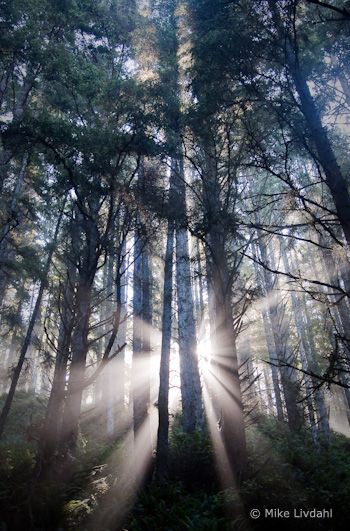
“Forest Sunrise #1 – Olympic National Park” by Mike Livdahl
This week’s photograph was made by Mike Livdahl in Olympic National Park, Washington. By having his image chosen for this critique Mike will receive a free 16×20 matted print from Aspen Creek Photo. If you’d like your images considered for future critiques you can upload them to the Flickr group I created for this purpose.
The most striking thing about this photograph is the fantastic light, with sunbeams radiating through the mist from behind tall trees. Light is the essence of photography. When we press the shutter we’re not recording objects, we’re capturing light. Often great light is enough to make a great photograph, even if the subject isn’t that interesting. These trees are nice, but without those sunbeams this would be a rather ordinary scene.
The exposure for such strong backlight can be tricky, but Mike handled it well. We see detail in all but the darkest parts of the tree trunks, yet the only the very brightest highlights are blown out. This is one of those rare instances where it’s okay to have some small washed-out areas in the photo, because this is something we would see in real life: looking at this scene the sun and adjacent sky would be blinding, and we wouldn’t expect to see detail in those areas in a photograph.
Mike said that he “exposed hoping to keep some life in the shadows.” As a result, he had to (in Lightroom) “damp the highlights pretty heavily, Recovery pushed to +81 and Brightness dropped to +29.” I guess that’s testimony to how much hidden detail can reside in seemingly overexposed highlights in Raw files. But if I were photographing this scene I’d keep my options open by bracketing exposures, allowing me to blend two or more images together later if necessary.
While the light in this photograph is exceptional, even great light could be ruined by a poor composition. Fortunately it wasn’t. The composition is clean and simple, with a strong focal point, the sunbeams, and some nice repetition created by the lines of the tree trunks. Mike chose a vertical orientation to emphasize the height of the trees. The sunbeams are centered from left to right, a configuration that works well in most vertical compositions (see my post about Sideways Photography).
That vertical orientation, however, with the sunbeams near the bottom of the frame, leaves a lot of space in the top half of the photo. The bottom part of the image is clearly the most eye-catching area, and I always think it’s best to fill the frame with the most interesting stuff. There seems to be a natural horizontal composition here, including only the areas around the sunbeams:
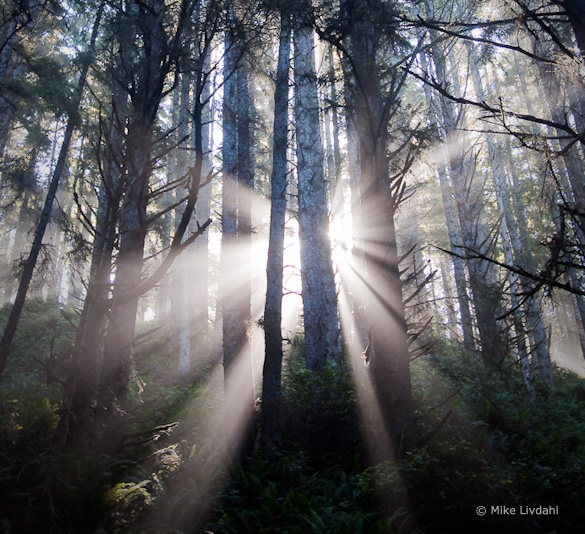
Alternate, horizontal crop
I think this tighter, horizontal framing has more impact, but it doesn’t convey the trees’ height, and loses some sense of place as well. So it’s a tradeoff. Which version do you prefer? Post a comment to share your thoughts on this.
Mike said that he handheld this photograph, leaning against a tree, at 1/15th sec. and 5.6 with an ISO of 400. Since this shutter speed resulted in a slightly soft photo, he added extra sharpening in Lightroom. In a larger view some of the closest branches are a bit soft, indicating that the wide f/5.6 aperture wasn’t enough to keep everything in focus. Obviously a tripod would have been a good idea here—it would have prevented camera movement while allowing a smaller aperture with more depth of field.
The post-processing looks well done; the white balance looks right, and the heavy use of the Recovery tool created a perfect range of contrast—small areas of black, small areas of white, with a full range of tones in between.
Overall this is well done—beautiful light composed well.
Thanks Mike for sharing your image! You can see more his work on Flickr.
If you like these critiques, share them with a friend! Email this article, or click on one of the buttons below to post it on Facebook or Twitter.
As part of being chosen for this week’s critique Mike will receive a free 16×20 matted print courtesy of the folks at Aspen Creek Photo. If you’d like your images considered for future critiques, just upload them to the Flickr group I created for this purpose. If you’re not a Flickr member yet, joining is free and easy. You’ll have to read and accept the rules for the group before adding images, and please, no more than five photos per person per week. I’ll be posting the next critique in two weeks. Thanks for participating!
by Michael Frye | Jun 21, 2010 | Yosemite Photo Conditions
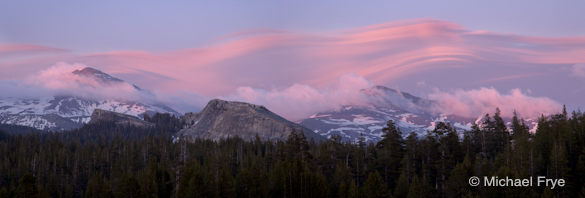
Lenticular cloud above Mounts Dana and Gibbs
Saturday Claudia and I drove up to Tuolumne Meadows. There was still lots of snow in the high country—not as much as when the pass first opened, of course, but plenty. We hiked around Pothole Dome to the place where the Tuolumne River starts to tumble down from the west end of the meadows, as I wanted to photograph these cascades with high water. We had the place to ourselves and it was beautiful. Claudia took a short video of that upper cascade, which I posted on Facebook.
We kept our eyes on a big lenticular cloud that had formed over the mountains to the north, but it seemed to dissipate near the end of the day. As we walked back up to the main meadow near sunset, however, we saw that a smaller lenticular cloud was riding above Mt. Gibbs, so we rushed to a spot closer to the road and caught the last sunset light on the mountains. I assembled the panorama above from two images zoomed in on the peaks.
We didn’t get home until 11 p.m., but it was worth it. We had a great afternoon in a special place.
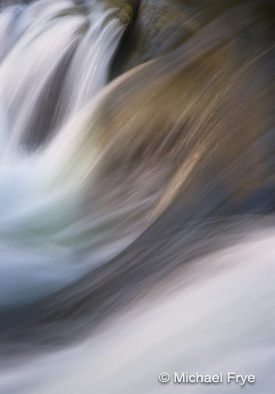
Water leaving Tuolumne Meadows (this is the cascade in the video)
by Michael Frye | Jun 16, 2010 | Critiques
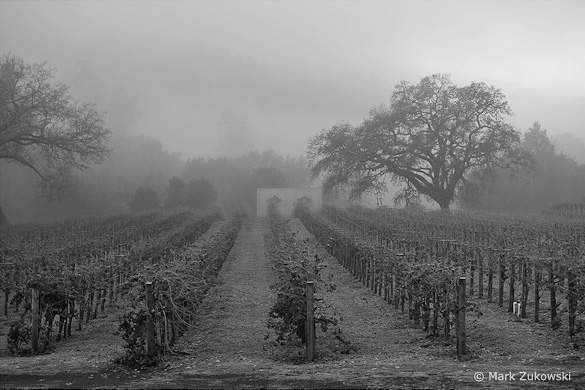
“Fog Shrouded Merlot” by Mark Zukowski
This week’s photograph was made by Mark Zukowski in Sonoma County, California. By having his image chosen for this critique Mark will receive a free 16×20 matted print from Aspen Creek Photo. If you’d like your images considered for future critiques you can upload them to the Flickr group I created for this purpose.
Mark made this image at his own vineyard. Nice place! Finding photogenic areas near your home can reap rewards, allowing you to take advantage of fleeting weather conditions. Mark did that here, using the fog to create a wonderfully moody photograph.
This image was originally captured in color, in Raw. Mark said he initially struggled with the white balance, and that’s one of the reasons he tried converting this to black and white. Here’s the color version, and I see what he means about the white balance: something seems off about the color, although it’s hard to pinpoint whether it’s color temperature or camera calibration. But even if the color could be improved this photograph would still be better in black and white. The slightly warm-toned monochrome treatment adds to the mood and gives the image an old-world feeling that seems appropriate for this setting.
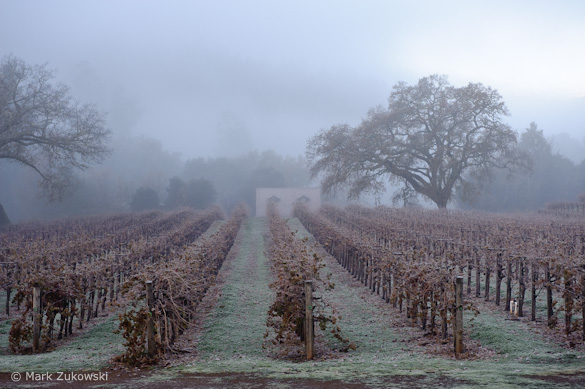
The color version
I like the way the rows of grapevines lead my eyes right to the building in the background. The craggy oak right of center has a great shape, and adds an interesting focal point. Overall the composition works well.
One thing that bothers me however is the patch of dark ground at the very bottom of the frame, as it draws my attention away from more interesting things above. Trimming this edge a bit to eliminate the darkest patches of ground seems to help:
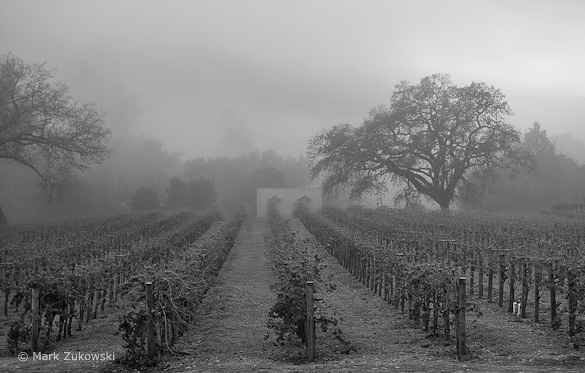
After trimming the bottom edge
We see only part of the tree along the left side, and that’s normally a problem, as prominent elements like this can become distracting when hanging along the edge. Here though that tree seems to work, as it adds an echo to the tree right of center, and cropping it out leaves the left side of the picture somewhat empty.
But perhaps this might have worked even better if Mark had included all of that left-edge tree, creating even stronger repetition between the shapes of the two oaks. Of course there may have been some distracting element just outside the picture that prompted Mark to frame the image this way. Even if there wasn’t, including all of that left-hand tree would have required zooming out and adding either more sky or more foreground, neither of which would be desirable. But cropping into more of a panoramic shape probably would have solved that.
Another idea would have been stepping further to the left, which would have brought the two trees closer together visually. From a certain angle the building could have been neatly framed between the two trees. Of course moving to the left would have changed the alignment of the grapevines, so instead of leading our eyes right to the house they would lead toward the trees left of the house. Another issue is that, as we see it now, the tree right of center stands out clearly against a lighter background; there seems to be a small gap in the trees behind it, allowing lighter fog to show through. Stepping to the left probably would have positioned that tree against the darker vegetation that we now see on the right edge of the frame. So maybe moving to the left wouldn’t have worked, but it’s always worth thinking about different camera positions when you’re there, behind the camera, and have a chance to improve the composition.
Mark used a 70 mm lens on a Nikon D700, giving the image a short telephoto perspective with this full-frame sensor. The exposure was 1/125 sec. at f/5.6 with 200 ISO. This is a pretty wide aperture, and while everything appears looks in focus at this small size, a bigger enlargement might reveal softness in the foreground or background. A smaller aperture, like f/11 or more, might have been a better choice to expand the depth of field and ensure that everything was in focus. Of course this would have required a slower shutter speed and necessitated a tripod.
The exposure and contrast look just right. The sky in the upper-right corner is the brightest part of the scene, but not really where you want people to look most, so that area should probably be darkened a bit.
But overall this photograph is very well done. It has a great mood, enhanced by the warm-toned black-and-white treatment. If you communicate a feeling, you’ve done your job as a photographer.
Thanks Mark for sharing your image! You can see more his work on Flickr.
If you like these critiques, share them with a friend! Email this article, or click on one of the buttons below to post it on Facebook or Twitter.
As part of being chosen for this week’s critique John will receive a free 16×20 matted print courtesy of the folks at Aspen Creek Photo. If you’d like your images considered for future critiques, just upload them to the Flickr group I created for this purpose. If you’re not a Flickr member yet, joining is free and easy. You’ll have to read and accept the rules for the group before adding images, and please, no more than five photos per person per week. I’ll be posting the next critique in two weeks. Thanks for participating!

















